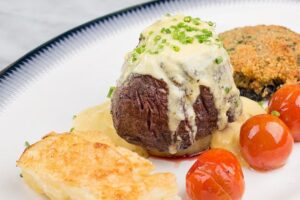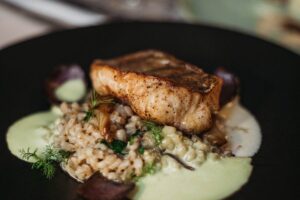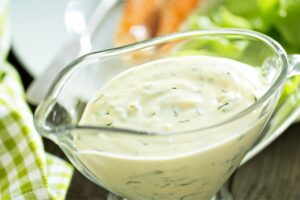Beurre blanc and bearnaise are some of the most popular sauces in the world. Beurre blanc is a favorite for people who love seafood and fish while bearnaise is a go-to sauce for those who love steak.

This beurre blanc vs bearnaise article compares the two and provides a step-by-step guide on how to prepare either.
What Is Beurre Blanc?
Beurre blanc is a sauce made of butter that is popular with seafood or fish. While a newcomer compared to sauces such as veloute, it is a favorite for most foodies. A product of Nantes, France, it was discovered in the 1890s.
Most people credit chef Clemence Lefeuvre for accidentally inventing the sauce. Unfortunately, most people confuse bearnaise sauce with beurre blanc. While the former uses liquid clarified butter, the latter uses whole butter.
This explains why beurre blanc tastes velvety and rich. It is also tangy and sweet, making it an ideal sauce for seafood.
What Is Bearnaise Sauce?
Bearnaise is a sauce made of egg yolk, butter, white-wine vinegar, and herbs. It is closely related to hollandaise sauce, with the main difference being the flavoring. Bearnaise uses tarragon, black pepper, and shallot, while hollandaise uses white pepper.
Like beurre blanc sauce, bearnaise originates from France. According to the legends, chef Jean-Louis-Francois Collient accidentally invented the sauce. It was first served in 1836 during the Le Pavillion Henri IV opening.
While a French invention, it gained traction in the Nordic countries in the 20th century, becoming a staple for local steak cuisine. It is also used as a topping on pizza.
Beurre Blanc vs Bearnaise: Comparison
So, what distinguishes the two?
Beurre blanc is a sauce made of butter, shallots, vinegar, and white-wine vinegar. It has a delicate and light flavor with a tangy and sweet finish.
It can also take on other flavors such as mustard, ginger, and chile. With it, you should use cold or whole butter only to achieve the creamy texture. And it pairs beautifully with fish or seafood.
Bearnaise sauce on the other hand is a bit complex. The ingredients include egg yolks, white-wine vinegar, clarified butter (butter without water content and dairy solids), and tarragon or chervil herbs.
It has a sweet, savory flavor and a creamy texture, making it an ideal sauce for red meats.

| Beurre blanc | Bearnaise sauce | |
| Ingredients | Butter, shallots, white wine, vinegar | Clarified butter, egg yolks, white wine vinegar, herbs (tarragon and chervil) |
| Flavor | Light, delicate, slightly sweet and tangy | Rich, slightly sweet, and savory |
| Texture | Thin, slightly creamy | Thick, creamy |
| Pairings | Seafood, fish | Steak, red meats |
Both beurre blanc and bearnaise sauces originate from France and are widely embraced across the world.
How To Prepare Beurre Blanc
To prepare beurre blanc, you’ll need the following:
Ingredients
- 1 tablespoon unsalted butter
- 1 cup white wine
- ½ cup white wine vinegar
- ¼ chopped shallots
- Salt to taste
Preparation Guide
- With the ingredients ready, cut the unsalted butter into medium cubes and transfer them to the refrigerator to keep them cold.
- Mix your white wine, vinegar, and shallot in a saucepan. Bring the mixture to a boil over high heat. Let the liquid boil for 30 to 40 minutes until it reduces to about 2 tablespoons.
- Now, reduce the heat to low, and take out the chopped butter cubes from your refrigerator. Add to 1 or 2 at a time, whisking them thoroughly. Add as many cubes as you can until the butter incorporates with the liquid. This should last anywhere between 30 and 40 minutes.
- After this, turn off the heat while still whisking the butter until you achieve a thick and smooth texture.
- You can then add salt to taste.
- Serve immediately with your favorite seafood or fish and enjoy.
If you want a luxurious recipe variation, consider using leftover champagne. Simply substitute champagne for the white wine. It will add a sweeter yet more complex flavor to your sauce.
In addition, you can prepare beurre rouge by using red wine vinegar and red wine. Unlike beurre blanc, it has a deeper and richer flavor. It is also darker, thicker, and creamier. So, feel free to play around with the recipe to your liking.
How to Prepare Bearnaise Sauce
Making bearnaise sauce is more complicated than beurre blanc. Here is what you’ll need:
Ingredients
- White wine vinegar
- Shallot or eschalot
- Tarragon
- Chervil
- White wine
- Egg yolks
- Clarified butter

Preparation Guide
- First, infuse the vinegar by simmering it with shallot, herbs, and white wine in a small saucepan over medium-low heat for about 2 minutes. Remove the saucepan from the stove and let it sit for about 5 minutes. This will let the vinegar infuse with flavor.
- Press as much liquid as you can from the mixture. Ideally, you should have at least a tablespoon of vinegar with 1 ½ being the maximum. If you have less than 1 tablespoon, top it up with water.
- Next, you need to make clarified butter. Melt the butter in a heatproof jug using a microwave. Avoid melting it at once as this can cause it to explode. We recommend doing it in bursts of 30 seconds.
- Once melted, let it sit for at least 30 seconds. You’ll notice that white sediments will settle at the bottom while the golden liquid will settle on top. This is the clarified butter.
- Transfer the clarified butter into a cup and measure ¾ of it. You can discard the white solids.
- The next step is to get the egg yolks. While the eggs are fridge-cold, crack them into your fingers and let the white part slip through. Transfer the yolks into a bowl and let the de-chill for about 15 minutes. This will allow proper incorporation with the vinegar.
- Place your egg yolks, infused vinegar, and salt in a container. Use a stick blender to blitz for a seamless combination.
- As the blender blitzes the mixture, gradually add the clarified butter, allowing the sauce to emulsify properly. You should not add the butter at once as this would lead to splitting rather than emulsifying.
- Continue blitzing for another 10 to 20 seconds until you get a smooth sauce.
- As of now, the sauce is still thick. And this is not what you want. You want a somewhat thin sauce that you can dollop onto your steak.
- So, you’ll need to add water gradually as you blitz the sauce until you achieve your desired thickness.
- Finally, add your chervil and tarragon herbs to add that fresh taste.
- You can now serve it with your favorite red meat.
Beurre Blanc vs Bearnaise: Final Thoughts
Beurre blanc is an easy-to-prepare sauce, requiring fewer ingredients than bearnaise. With it, you can enjoy your seafood, fish, or poultry. And if you want it sweeter, you can opt for the beurre rogue option.
Bearnaise on the other hand is daunting to prepare, if you are a beginner. But when made correctly, you are sure to enjoy a savory steak.
